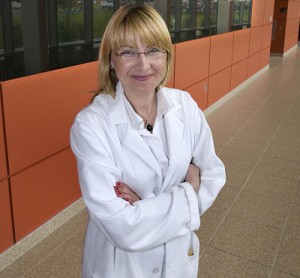Justyna Widera, Ph.D., has devoted a significant portion of her research career to studying and testing materials that will lead to more efficient solar cells.

Justyna Widera, Ph.D., has devoted a significant portion of her research career to studying and testing materials that will lead to more efficient solar cells.
Thanks in part to generous federal tax breaks, solar energy use in the United States is inching up. According to the Solar Energy Industries Association, 36 percent of new electric capacity in the United States in 2014 came from solar energy. Another report by The Solar Foundation indicated that solar industry employment grew by 40 percent in New York State in 2014.
The keys to sustained solar energy growth are greater efficiency and lower costs. That is where chemists like Justyna Widera, Ph.D., an associate professor at Adelphi’s College of Arts and Sciences, play a crucial role. Dr. Widera has devoted a significant portion of her research career to studying and testing materials that will lead to more efficient solar cells.
Most recently, Dr. Widera has teamed up with fellow scientists at the University of Warsaw in Poland to study the electrodeposition of three types of nanoparticles—cadmium, tellurium and cadmium telluride.
More simply put, solar cells, like computer chips, are made of semiconductors. Dr. Widera and her collaborators are studying novel types of semiconducting materials that will maximize energy output. An added benefit of the new materials is that they could make solar cells cheaper and easier to produce. “The semiconductors used for the current state-of-the-art [solar cells] are very expensive because it is difficult to produce them with no defects in the structures,” Dr. Widera said. She pointed out that the materials and synthetic processes that she and her collaborators are proposing will be far more affordable.
Equally exciting, Dr. Widera has involved undergraduates in her research. Last summer, with support from Adelphi’s Horace McDonell Fellowship and the Honors College Summer Research Fellowship, she brought two students—Vivian Matubia and Diana Chaykina—to Poland to conduct research with her and her colleagues. Next summer, she plans to bring two more students to Poland.
Since the summer, Dr. Widera and a colleague have been looking at the effects of adding polymers to the nanoparticles. The next step is to add enzymes to the mix.
Dr. Widera is confident that her accumulated knowledge from past research and future endeavors will pay off in the next generation of solar cells. “Sometimes what happens is you combine all of your knowledge and you come up with one great idea of a novel design of solar cell that’s actually a synthesis of all the different parts you studied before,” she said.
For further information, please contact:
Todd Wilson
Strategic Communications Director
p – 516.237.8634
e – twilson@adelphi.edu